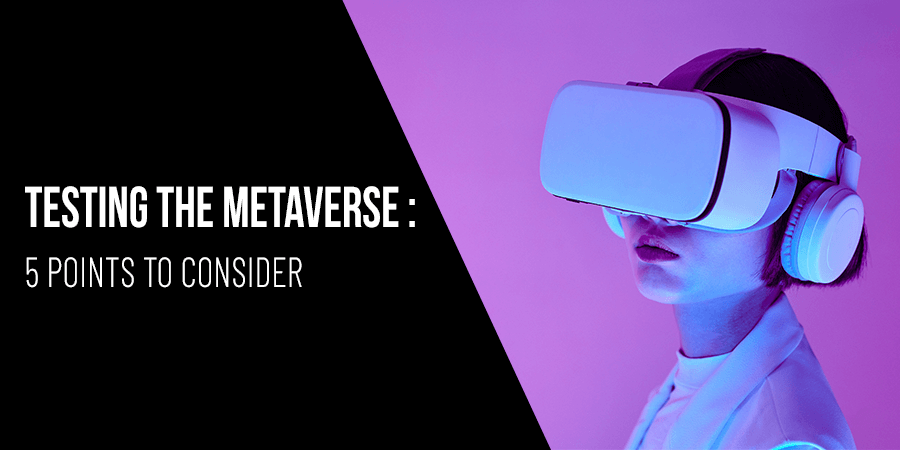While the metaverse may be the next big thing, it, like our current mobile applications, websites, and software solutions, must be tested thoroughly in order to provide users with experience and innovation that the industry is promosing.
What is the Metaverse?
You can think of the metaverse as the next-generation of the Internet, which will use both virtual reality (VR) and augmented reality (AR) to create 3D online experience. This experience will allow people to interact with objects and one another in new virtual spaces, which is not currently possible with today’s 2D online experience.
It is also important to note that the metaverse also has mutliple applications including gaming, social interactions, entertainment, tourism, education, work, and more.
While the future looks bright for the metaverse, it’s success like that of other digital services, will be tied to its ability to offer innovative features and a great user experience. That is why it is imperative for organizations to test their metaverse platforms.
Below, discover 5 different types of tests that will help to protect the quality of the metaverse.
Metaverse Testing Advice: What to consider
Performance Testing
For any mobile application or website, its speed, responiveness, and stability are all essiential elements for a great user experience. For the metaverse, the same holds true. To optimize quality, performance testing is vital to uncover issues or bottlenecks that can hinder a platform’s stability, speed, responsiveness, and scalability under normal and heavy user loads.
The enormous amount of data and ultra fast networks required to power AR and VR experiences also make performance testing exceptionally important for the metaverse. Finding and reducing latency issues is absolutely neccessary for maximizing the quality of AR and VR experences and improving the overall user experience.
Functional Testing
For any digital service including the metaverse, functional testing is super important in helping organizations to deliver a flawless user experience.
As its name implies, funcitonal testing consists of evaluating functionalities to determine if they work as expected. As bugs are uncovered, the development team can fix these errors improving the quality of the platform.
Usability Testing
Unlike functional testing, usability testing takes a more global approach to assess the user experience. Best executed by end-users with real devices in a real world enviroment, usability testing aims to find issues or flaws that would not be considered bugs or anomalies but nonetheless make help to create a dissapointing user experience.
With the metaverse, usability testing should be used to evaluate the overall quality of the platform as well as the AR and VR experiences offered. In particular, usability testing can help organization improve their platform by uncovering areas or aspects that can be improved, identifying design flaws that hinder the user interface, gaining a better understanding of how users are interacting with the platform.
Compatibility Testing
Besides testing the functionalities as well as the usability, it is equally important to ensure the compatibility of the metaverse platform with external devices that will allow users to connect and use the metaverse.
Unlike our traditional online experience today, the metaverse’s AR and VR experience will depend on and be enhanced by external devices. This includes VR headsets, AR glasses, AR sensors, and variety of wearables. As a result, tests must be executed to ensure these devices can be connected and used seemlessly with the metaverse platform.
Accessibility Testing
As a digital service, metaverse must embrace accessibility standards to be able to offer everyone a first-rate user experience.
While there are signficant differences between traditional applications and webistes and the metaverse, there is still a lot that can be done to create a metaverse that is inclusive and accessible.
The first step to building an accessible metaverse will require organizations to prioritize accessibility during the development phase of these platforms. Here, focus should be placed on Web Content Accessibility Guideline (WCAG) guidelines ensure the metaverse’s content is perceivable, operable, understandable, and robust.
The second step will be to carry out the accessibility tests to ensure the platform is accessible to all users. It is best to execute these tests to ensure that all users can properly access, navigate, interact, and understand the content or information being offered or presented.
Some aspects to look for include :
- The presence of closed captions for video or audio content
- The use of alternative control to help people navigate or execution actions
- The use of alt tags for visual elements
- Text that has high contrast with its background
How StarDust CTG can help
A leader in QA testing, StarDust has the resources (VR headsets), expertise, and know-how to accompangy you during your testing phases to optimize the quality of your digital services. To learn more about our services, do not hesitate to contact us.





